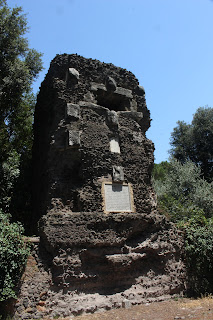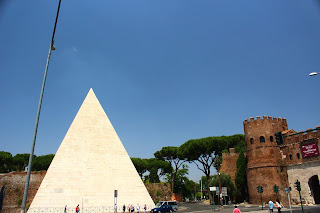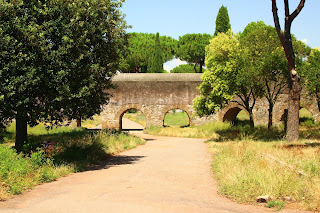So coming down from the Knights of Malta Keyhole, we began our great trek to the South to take in our last ancient parts of Rome before our flight this afternoon.
The first stop was perhaps one of the least known remaining features of ancient Rome (I sure had no idea about it till we started researching), the Pyramid of Caius Cesitus... Wait, What! A pyramid, in Rome!. Yes and Yes.
The Pyramid is actually a burial tomb of Gaius Cestius, who was a magistrate in Rome. The tomb was built around 15 B.C., and today, is one of the most well preserved ancient buildings in Rome, thanks in no small part to it's incorporation into the ancient city wall of Rome. What should be no surprise, the dimensions of the pyramid are exactly 100 Roman feet (29.6m) square at the base, and 125 Roman feet (37 m) tall. It's hard to conceive how exact the measurements are, and how sturdy the construction was.
When it was originally constructed, it stood in the countryside, outside the current city limits of Rome, which had a ban on tombs within the city wall. As Rome grew enormously during the next two centuries, the pyramid became surrounded by the city, and when the most recent (well 270 CE) Aurelian Walls were constructed around the city, the pyramid was incorporated into the wall at the Porta San Paolo.
Throughout the intervening centuries, the purpose of the pyramid was generally lost to history, often believed to be the tomb of Remus, as there was another pyramid near Vatican (dismantled in the 16th c., and stones used for the stairs of St. Peter's Basilica - Recycle, Reduce, Reuse!) housing the tomb of Romulus.
It underwent major excavation in the 1600's and restoration in the early 2000's, during which the contents (that haven't been pillaged) were catalogued, and the exterior of the pyramid restored. We got to see the (reasonably) newly revealed work.
Pyramid of Caius Cestius
 |
| Pyramid of Caius Cestius |
This actually got to be a double-visit, as the protestant cemetery (or anti-catholic cemetery) lies just adjacent to the pyramid. This cemetery is the resting place of many foreign born residents of Rome, commonly British, who would have been visiting the area to experience the curative powers of the Mediterranean air. One of these individuals was John Keats who died at 25 of Tuberculosis.
This grave contains all that was mortal, of a young English poet,
who on his death bed, in the bitterness of his heart,
at the malicious power of his enemies, desired these words
to be engraven on his tombstone:
Here lies one whose name was writ in water.
As Rome began expanding, the need to move troops and goods around the empire become more and more important. Existing routes were mainly dirt track, often weathered by animal or human passage, and not at all suitable for high-volume traffic. So the Romans began extending routes to the edges of the Empire, with Rome being the focal point. This is the source of the phrase "All roads lead to Rome".
Appia was among the first routes laid out (in 300 BC), and a large portion of it is still in use. While the roadway itself has been upgraded (dozens of times I suspect) over the centuries, there are many remnants along the way to remind you of it's age, and importance.
We started our walk at the Catacombs of St. Callixtus, but due to timing, we didn't pop in there.
We did however pass this old gate, which we think was used to collect tolls from passengers. There were some inscriptions to suggest the original tower was dedicated to a deceased daughter
 |
| This is one of the castles or tax stops along the way (it possibly served both functions) |
 |
| The remains of an old wall along the road. |
 |
| Some of the houses along the Appian Way were just gorgeous. |
Our route back into modern Rome from the furthest extents of the Appian Way, included a bit more ancient Roman history along the way.
We've alluded to it several times... the Ancient Romans were great with their water. They built extensive aqueducts to supply Rome and other major centres with significant quantities of water for drinking, bathing, and to flush away wastes. By the 3rd century AD, eleven aqueducts served Rome.
The aqueducts were constructed on a slight downward gradient so water flowed by gravity. Most were constructed underground or would follow the contours of the land, but occasionally, they were constructed on raised bridgework and arched structures, like what comes to mind when talking about aqueducts. I remember them being noted in my civil engineering courses for the precision of their construction. Many of the aqueducts will run for more than 50 km, carry more than 100 000 m3 of water per day, and be constructed with a slope of less than 0.05% (less than 50 cm over 1 km); all this as they wind through hillsides and across vast valleys! At the peak, they supplied Rome with more than 1 million m3 of water per day; enough for a modern city of 3-5 million people.
There is one section of the ancient Aqua Claudia that is still standing today, and runs mostly adjacent to the Appian Way, so off we set to find it.
This aqueduct was one of the later constructed; around 40 AD to supply water from a spring about 70 km away from the city. Most of the aqueduct was underground, but as it neared the city, arches were required to maintain the grade. The tallest of these rose more than 100 feet above ground.
Today, much of the arches are missing, but a surprisingly long section is still visible in Parco degli Acquedotti. We found it quite funny at the point we crossed under the aqueduct, a sheep herder was moving his flock along the road ahead of us. I think the sheep were entirely unaware of the significance.
 |
 |
| An overload of civility |
 |
| Large Arches |
This was a much smaller aqueduct (covered) running through the park as well. I believe this one is still in use, whereas the large sections missing from the grander one probably cause unacceptable losses.
 |
| Tiny Arches |
So that brought us to the end of our Rome tour. We left the aqueduct park, and made a quick stop at our AirBNB to get our bags before heading to the airport.
I know I missed out on a lot of the artistic importance of Rome, Italy and the Vatican, but the civil engineer and lover of old remaining things really enjoyed the trip and all of the exploring of old Rome that we got to walk around.














1 comment:
#engineeringforthewin
Post a Comment